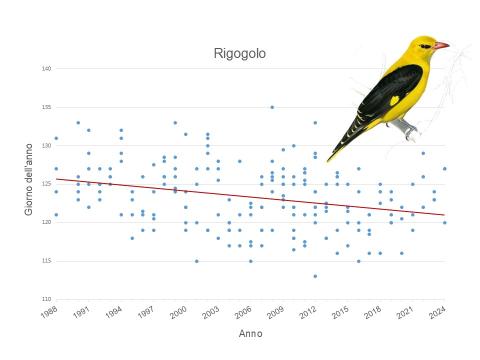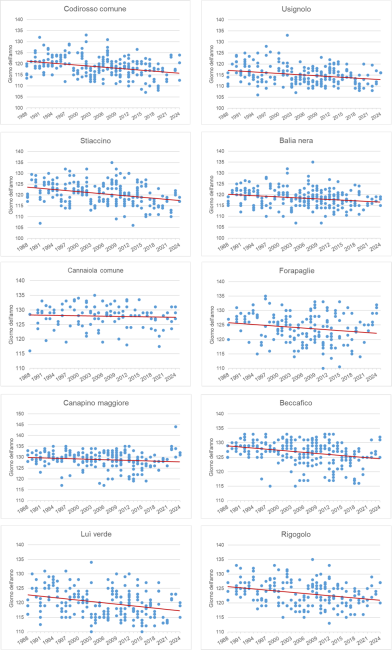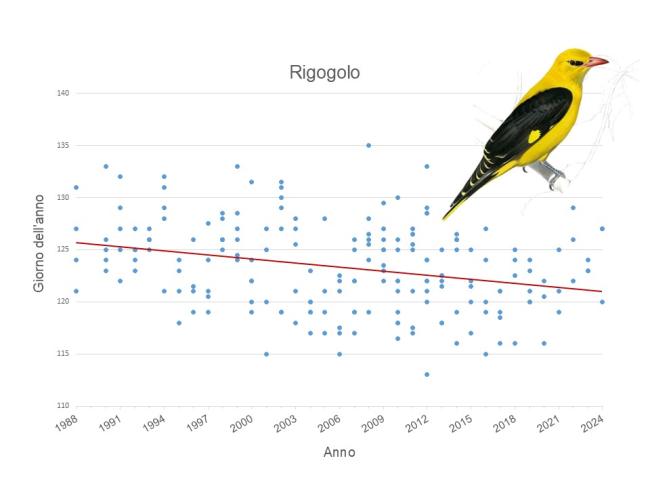Panel 1
Jacopo G. Cecere, Simona Imperio
The indicator provides an overview of the health status of common migratory passerine bird populations in Europe through an assessment of their resilience to climate change. The increase in spring temperatures due to global warming causes an earlier seasonal onset of vegetation and, consequently, of the insect peak. As a result, if migratory birds do not advance their arrival at breeding sites to the same extent, they fail to encounter an abundance of prey at the critical time for feeding chicks. A failure to advance migration timing therefore translates into low resilience of migratory populations to climate change, with negative consequences for their survival.
The analysis focuses on the temporal variation in the arrival dates of migratory passerines at stopover sites used after crossing the Sahara and the Mediterranean Sea during their spring journey from Africa to European breeding grounds. Based on an analysis of the migration dates of 10 bird species recorded at 26 ringing stations participating in the ISPRA Small Islands Project from 1988 to 2024 (37 years), it is observed that 60% of the studied species show a migration advance that is too slow (about 1 day every 7+ years) to be considered sufficient to offset the effects of climate change.
The indicator is based on data collected under the Small Islands Project, coordinated by ISPRA and active continuously since 1988, with the aim of studying and monitoring the migration phenology of passerine birds that winter south of the Sahara, using bird ringing techniques. The Small Islands Project applies standardized ringing protocols at strategic stopover sites for passerines during spring migration (small islands as well as coastal sites), from April 16 to May 15 each year.
The indicator considers 10 species of passerines: Common Redstart, Nightingale, Whinchat, Collared Flycatcher, Eurasian Reed Warbler, Sedge Warbler, Melodious Warbler, Garden Warbler, Wood Warbler, and Golden Oriole. For each species, the temporal variation in the median passage date at sampling sites was analyzed over the period 1988–2024, taking into account possible site-specific variations in migratory passage across the 26 stations that participated in the project over the years.
To assess the resilience of small migratory birds to climate change, through the analysis of variations in the spring migration dates of 10 bird species.
Birds Directive (2009/147/EC):
Objective: to maintain bird species in a favorable conservation status.
Bonn Convention – CMS – Convention on the Conservation of Migratory Species of Wild Animals:
Objective: to ensure a favorable conservation status for migratory species.
Law 157/92 – Regulations for the protection of warm-blooded wildlife and hunting:
Objective: to maintain bird species in a favorable conservation status.
Panel 2
Both, C., & Visser, M. E. (2001). Adjustment to climate change is constrained by arrival date in a long-distance migrant bird. Nature, 411(6835), 296-298.
Jonzén, N., Lindén, A., Ergon, T., Knudsen, E., Vik, J. O., Rubolini, D., ... & Stervander, M. (2006). Rapid advance of spring arrival dates in long-distance migratory birds. Science, 312(5782), 1959-1961.
Møller, A. P., Rubolini, D., & Lehikoinen, E. (2008). Populations of migratory bird species that did not show a phenological response to climate change are declining. Proceedings of the National Academy of Sciences, 105(42), 16195-16200.
The sampling period (April 16 – May 15) thoroughly covers the migration period for many species (including the 10 analyzed), but not for all those recorded during the Small Islands Project.
None planned.
Data quality assessment
ISPRA (Italian National Institute for Environmental Protection and Research)
Bird ringing database managed by ISPRA’s Bird Ringing Section [see the map viewer of the ISPRA National Biodiversity Network for data consultation: http://geoviewer.nnb.isprambiente.it/mapreacter/#/]
National
1988-2024
Indicator assessment
The indicator is based on 10 passerine species: Common Redstart, Nightingale, Whinchat, Collared Flycatcher, Eurasian Reed Warbler, Sedge Warbler, Melodious Warbler, Garden Warbler, Wood Warbler, and Golden Oriole. For each species, the median capture dates (therefore passage and migration) were calculated for each year at each ringing site involved in the Small Islands Project.
A linear model was then built for each species, with the median capture date per year and site as the dependent variable and the year as the independent variable. The median date was only calculated when at least 3 individuals were captured at a site during the season (April 16 – May 15); usually, the number of birds captured per site per season is significantly higher than 3. Finally, the ringing site was included as a random factor in the model to account for intrinsic site effects, such as geographic location (e.g., birds from Africa reach low-latitude sites earlier than higher-altitude ones) and the involvement of different populations (with different phenologies) of the same species at each site.
For 2024, the indicator shows an apparently favorable outlook for 40% of the migratory species analyzed. The remaining 60% do not significantly advance their spring migration date, thus displaying a low degree of resilience to climate change.
The trend is negative because the historical series analysis (Figure 1) shows that the Garden Warbler advances its median migration date by 1 day every 8.1 years, the Nightingale by 1 day/11.6 years, the Melodious Warbler by 1 day/11.5 years, the Golden Oriole by 1 day/7.6 years, and the Sedge Warbler by 1 day/8.1 years, while for the Eurasian Reed Warbler, no change in the median migration date was detected over the 37-year period.
On the other hand, an advance of more than 1 day every 7 years can be considered favorable for a species, as it is likely sufficient to counteract the drawbacks resulting from rising spring temperatures, assuming other threat factors (e.g., habitat alteration) remain constant. This more favorable situation was observed for the Common Redstart, Collared Flycatcher, Whinchat, and Wood Warbler, which show an advance in median migration date of 1 day every 6.8 – 6.1 – 6.3 – 6.5 years, respectively.
Data
Figure 1: Trend of the median passage date at the Small Islands Project ringing stations from 1988 to 2024 for 10 common trans-Saharan migratory passerine species in Europe during spring migration
ISPRA
On the y-axis, the value 100 corresponds to April 10, while the value 140 corresponds to May 20. The number of active ringing stations varies by year (min 2 in 1989, max 15 in 2012), and not all stations detect all 10 target species each year.



Resilience to climate change directly and indirectly affects the conservation status of migratory bird species. The relationship between temporal variation in migration date and the conservation status of migratory birds in Europe has been demonstrated in several scientific studies: species that have not adapted to global warming by significantly advancing their migration dates are now in poor conservation status.
The analysis of the 10 considered species shows a biologically significant advance in spring migration for the Common Redstart, Collared Flycatcher, Whinchat, and Wood Warbler—species that seem to display some resilience to global warming. Conversely, the Garden Warbler, Nightingale, Melodious Warbler, Golden Oriole, Sedge Warbler, and Eurasian Reed Warbler show either no or too slow an advance in spring migration (1 day every 7+ years), likely failing to adequately respond to environmental changes caused by increasing spring temperatures (Figure 1).